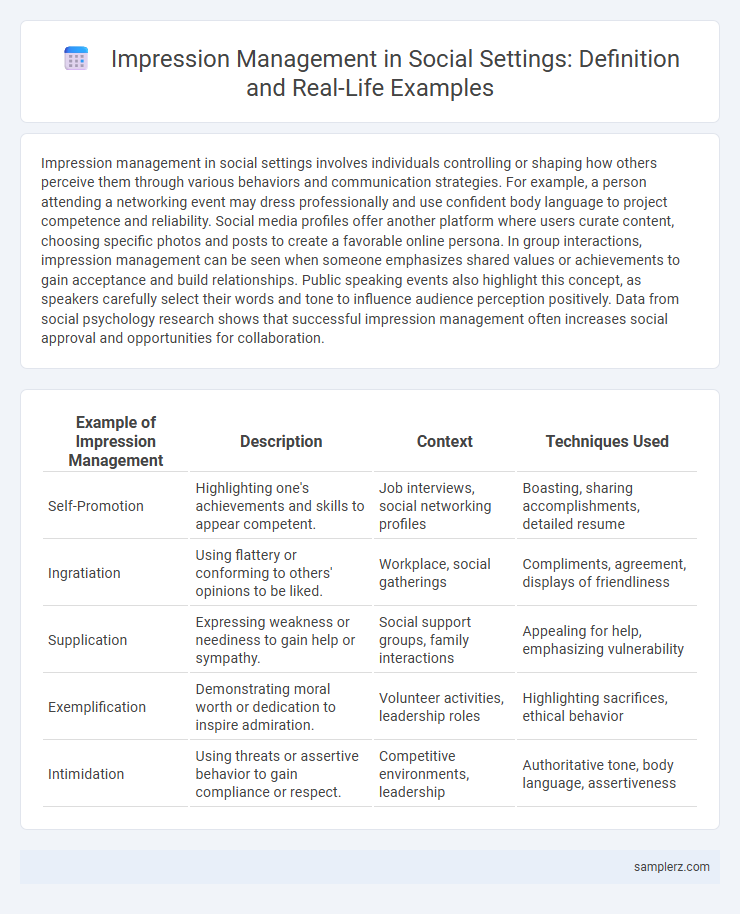Impression management in social settings involves individuals controlling or shaping how others perceive them through various behaviors and communication strategies. For example, a person attending a networking event may dress professionally and use confident body language to project competence and reliability. Social media profiles offer another platform where users curate content, choosing specific photos and posts to create a favorable online persona. In group interactions, impression management can be seen when someone emphasizes shared values or achievements to gain acceptance and build relationships. Public speaking events also highlight this concept, as speakers carefully select their words and tone to influence audience perception positively. Data from social psychology research shows that successful impression management often increases social approval and opportunities for collaboration.
Table of Comparison
| Example of Impression Management | Description | Context | Techniques Used |
|---|---|---|---|
| Self-Promotion | Highlighting one's achievements and skills to appear competent. | Job interviews, social networking profiles | Boasting, sharing accomplishments, detailed resume |
| Ingratiation | Using flattery or conforming to others' opinions to be liked. | Workplace, social gatherings | Compliments, agreement, displays of friendliness |
| Supplication | Expressing weakness or neediness to gain help or sympathy. | Social support groups, family interactions | Appealing for help, emphasizing vulnerability |
| Exemplification | Demonstrating moral worth or dedication to inspire admiration. | Volunteer activities, leadership roles | Highlighting sacrifices, ethical behavior |
| Intimidation | Using threats or assertive behavior to gain compliance or respect. | Competitive environments, leadership | Authoritative tone, body language, assertiveness |
Crafting First Impressions in Social Gatherings
Crafting first impressions in social gatherings involves carefully selecting attire, body language, and conversation topics to convey confidence and approachability. People often use subtle cues like maintaining eye contact, smiling, and mirroring gestures to enhance likability and build rapport quickly. These impression management strategies play a critical role in shaping others' perceptions and establishing social connections.
Managing Online Personas on Social Media
Managing online personas on social media involves carefully curating profiles, posts, and interactions to project a desired image that aligns with personal or professional goals. Users strategically select content, such as photos, status updates, and comments, to influence how others perceive their identity and social status. This process includes monitoring feedback and adjusting behavior to maintain consistency and authenticity across platforms.
Dress Codes and Appearance in Social Settings
Dress codes and appearance play a crucial role in impression management by signaling social status, professionalism, and cultural alignment in social settings. Adhering to specific attire norms helps individuals project desired identities and gain social acceptance within particular groups or events. Strategic choices in clothing, grooming, and accessories influence how others perceive credibility, approachability, and social belonging.
Conversational Tactics for Positive Perception
Using humor strategically in conversations enhances likability and creates a positive social impression. Employing active listening techniques, such as nodding and paraphrasing, signals attentiveness and fosters trust. Carefully choosing positive language and avoiding negative topics steers the interaction toward a favorable perception.
Self-Presentation in Professional Networking
Self-presentation in professional networking involves strategically highlighting skills, achievements, and expertise to create a favorable impression among peers and potential employers. Utilizing carefully crafted LinkedIn profiles, engaging in industry-specific discussions, and sharing relevant content serve as key methods to enhance visibility and credibility. Consistent impression management through these channels facilitates relationship-building and opens opportunities for career advancement.
The Role of Humor in Building Social Rapport
Humor serves as a powerful tool in impression management by easing social interactions and creating a positive atmosphere that fosters trust and likability. It helps individuals navigate social hierarchies by signaling intelligence, creativity, and approachability, which enhances social rapport. Effective use of humor can defuse tension, promote bonding, and establish a relatable personal identity in various social contexts.
Impression Management in Group Dynamics
Impression management in group dynamics involves individuals strategically shaping their behavior and communication to influence how they are perceived by other group members. Techniques such as self-promotion, ingratiation, and aligning with group norms are commonly employed to gain approval and enhance social standing within the group. Effective impression management can improve cooperation, increase influence, and strengthen group cohesion.
Navigating Social Expectations at Events
Impression management at social events involves carefully selecting attire, body language, and conversational topics to align with the expectations of the group and the event's cultural norms. Individuals often adjust their behavior to project confidence, likability, and social status, using subtle cues such as eye contact and tone of voice to influence others' perceptions. This strategic self-presentation helps maintain social harmony and enhances personal and professional relationships within the community.
Strategies for Handling Social Mistakes
Effective impression management in social settings involves strategies such as apology and corrective actions to handle social mistakes. Employing techniques like face-saving comments, humor, and nonverbal cues helps mitigate negative perceptions and restore social rapport. Adaptive responses, including acknowledgment of errors and sincere communication, significantly improve interpersonal trust and social acceptance.
Cultural Variations in Social Impression Management
Cultural variations significantly influence social impression management, shaping how individuals present themselves to others in various contexts. For example, in collectivist cultures like Japan, people often emphasize humility and group harmony to maintain social cohesion, while in individualistic cultures such as the United States, self-promotion and assertiveness are more common strategies. These differences highlight the importance of cultural norms in guiding behaviors related to impression management across societies.

example of impression management in social Infographic
 samplerz.com
samplerz.com